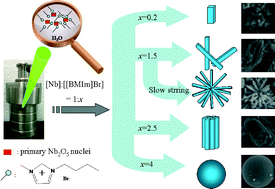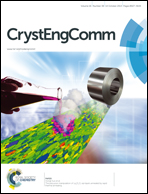(Ionic liquid)-derived morphology control of Nb2O5 materials and their photocatalytic properties†
Abstract
Pseudo-hexagonal TT phase Nb2O5 with various uniform crystalline morphologies such as nanorods, fibers, flower-like clusters, bundles, and porous spheres are fabricated using a hydrothermal synthesis route with ionic liquids as guiding agents. Among these morphologies, nanorods, flower-like clusters and bundles are firstly observed for Nb2O5. The morphology control is easily achieved by variation of the ionic liquid concentration. A primary mechanism study indicates a similar variation regulation for morphologies of Nb2O5 from rods to fibers and then spheres, when the ionic liquid concentration increases independent of the kind of ionic liquids. The photocatalytic activities of the obtained Nb2O5 with various morphologies are evaluated using the photodegradation of methylene blue. The results indicate that the catalytic performance depends on the morphology, and nanorods, fibers and clusters show superior activities even in a concentrated methylene blue solution. This study develops a facile way to control the crystalline morphology of Nb2O5 over a wide range and provides efficient photocatalysts using morphology control.


 Please wait while we load your content...
Please wait while we load your content...